ASRock DeskMini H470 Review: A No-Frills LGA 1200 mini-PC Platform
by Ganesh T S on December 29, 2020 8:00 AM ESTStorage and Networking Performance
Storage and networking are two major aspects which influence the experience with any computing system. This section presents results from our evaluation of the storage aspects in the ASRock DeskMini H470. On this aspect, one option would be repetition of our strenuous SSD review tests on the drive(s) in the PC. Fortunately, to avoid that overkill, UL PCMark 10 has a Full System Drive Benchmark storage test certain common workloads such as booting, loading games, and document processing are replayed on the target drive. The average access times and bandwidth numbers are recorded for each trace and the overall numbers contribute to a benchmark score.
In case of single drive systems, we attempt to allocate 180GB to the primary partition, and leave the remaining space on the drive as a secondary partition. For dual-drive systems, the OS drive is the primary drive, while the other is categorized as the secondary one. Since PCMark 10 requires 80GB of free space at the minimum for processing the Full System Drive Benchmark, we are able to process the benchmark on both the primary and secondary drive in only some of the evaluated systems. The results are presented below.
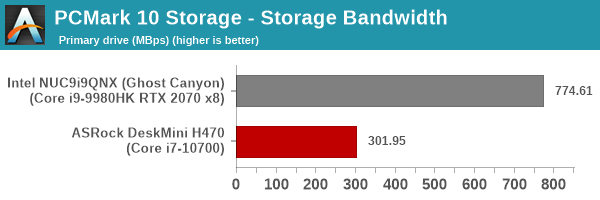
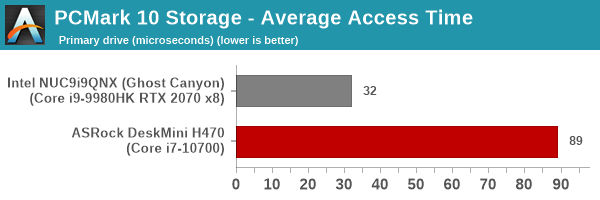
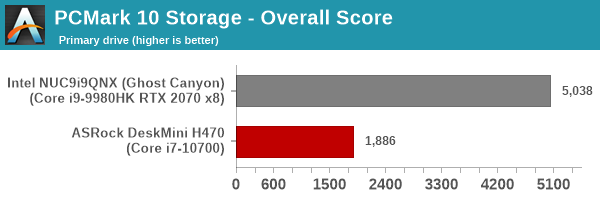
Since the PCMark 10 storage component is a recent addition to our benchmark suite, we only have the Ghost Canyon NUC for comparison. In the battle of primary drives, the Intel SSD 905p Optane drive is against the Crucial P5 with Micron's 96L 3D TLC NAND flash. Commensurate with the cost of the SSDs (~$500 @ around $1.33/GB for the 905p compared to ~$130 @ around $0.13/GB for the Crucial P5), the performance of the Optane drive is well ahead of the flash-based drive in the PCMark 10 storage benchmark numbers.

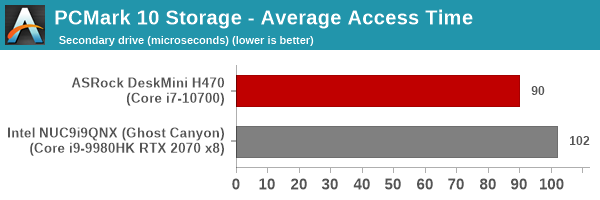
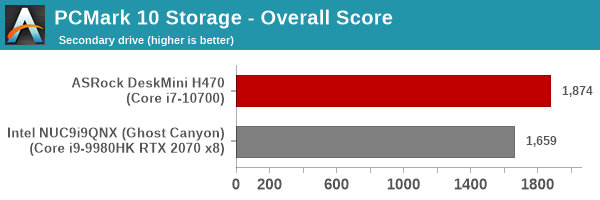
The second partition in the DeskMini H470 is still that of the Crucial P5 - despite the larger partition size and available free size, the numbers closely track those obtained for the primary partition - bandwidth around 301.5 MBps and an average access time for the workloads around 90us. Here, the compared drive in the Ghost Canyon NUC is the Kingston KC2000 - a more like-for-like comparison drive against the Crucial P5 SSD. Both drives are M.2 2280 PCIe 3.0 x4 NVMe drives with 96L 3D TLC flash and use a SSD controller with external DRAM support. Kingston has since replaced the KC2000 with KC2500, but the 1TB version still carries a distinct premium over the Crucial P5 (around $0.18/GB compared to the $0.13/GB) despite the P5 delivering better storage performance as per the PCMark 10 storage bench scores.
On the networking side, we restrict ourselves to the evaluation of the WLAN component in mini-PCs. Since the DeskMini H470 review sample didn't come with any Wi-Fi card, we do not have any iPerf3 benchmark results for the system. The unit has a single wired gigabit Ethernet port, good enough for networking duties in a standard PC. Consumers contemplating the use of the system for networking-focused applications such as firewalls or routers have better options available in the market.


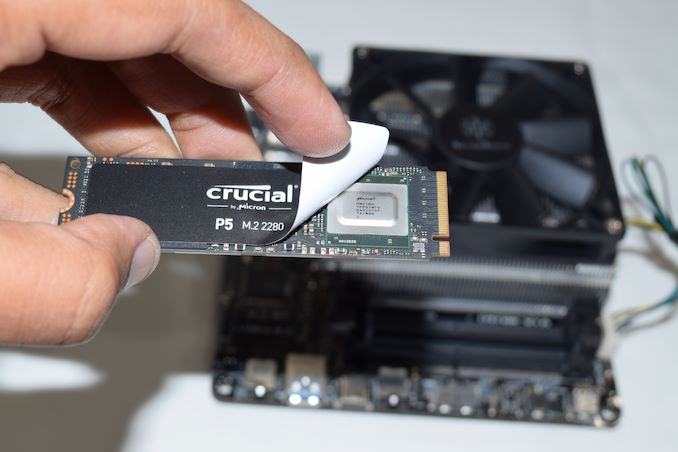








26 Comments
View All Comments
ingwe - Tuesday, December 29, 2020 - link
What a great value! I am impressed.JfromImaginstuff - Tuesday, December 29, 2020 - link
Seems pretty darn goodAdditionalPylons - Tuesday, December 29, 2020 - link
I agree that this is great value. Shame about not including 2.5 GbE though. Ganesh, are you planning to review the AMD counterpart Deskmini X300 as well? (Despite being a bit older it still supports the latest Renoir APUs.) Personally I'm hoping for something like this based on Cezanne APUs to be launched at CES. It is great having socketed CPU in the Deskmini, but I'd also gladly buy a Cezanne-based successor to e.g. Asus PN50, Gigabyte Brix or ASRockInd 4x4box.powerarmour - Tuesday, December 29, 2020 - link
Yep, not surprised it's the 'Intel' variant here...lmcd - Tuesday, December 29, 2020 - link
As a 2400G user, it makes sense why they didn't review it. It's dated.And Ian is the one that has the OEM-only APUs.
ganeshts - Tuesday, December 29, 2020 - link
I have a DeskMini X300 sample that arrived just a few days back along with a Renoir APU. Review should be out sometime in January.AdditionalPylons - Tuesday, December 29, 2020 - link
Great! Looking forward to that! And thanks a lot for this review as well!osteopathic1 - Tuesday, December 29, 2020 - link
How would this compare to a new Mac Mini with M1?At the same price point the mac has less ram/storage but does have an arguably more powerful processor and HDMI 2.0 for 4K at 60Hz.
The internal storage is likely not a factor anyway as most who use this as a HTPC will have external storage of some sort with their media on it.
Any thoughts?
fishingbait15 - Thursday, December 31, 2020 - link
Huh? With the exception of single core performance, the M1 chip isn't "arguably more powerful" than any hexacore or octacore Intel desktop chip. Most media and "tech" sites only compare the M1 to the dual and quad core "mobile" (more accurately laptop) chips that Apple replaced in the MacBook Air and entry level Mac Mini and MacBook Pros. The hexacore and octacore desktop chips are clearly more powerful, and it was that CPU that was used here. And with 16 GB of RAM instead of 8 GB that is in the $699 Mac Mini, the comparison favors this device even more.Further, I do not know if you missed it but this configuration has a pair of 4K displayports at 60Hz as well as a third 4K output at 30Hz and a 4th lower resolution output.
Most people will use this as a HTPC? Speak for yourself. It would work just fine for general purpose computing, and you can get an entry level graphics card to make it suitable for 1080p gaming for under $100. (Meanwhile the ARM CPU will make macOS even worse for gaming than before). The M1 Mac is a great accomplishment, and as a result we will see more ARM-based Windows, ChromeOS and Linux laptops starting maybe in late 2021 when hopefully SOMEONE will come out with a design that includes at least 2 Cortex X1 cores, or failing that more than 4 Cortex A78 cores. But devices like this are precisely why Wintel will continue to have a clear majority of the market.
wpcoe - Tuesday, December 29, 2020 - link
It looks like the motherboard tray is a solid piece of metal closely beneath the M.2 slot. How is the heat dissipation for an M.2 SSD?